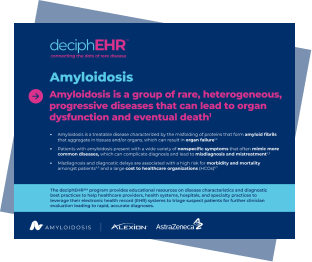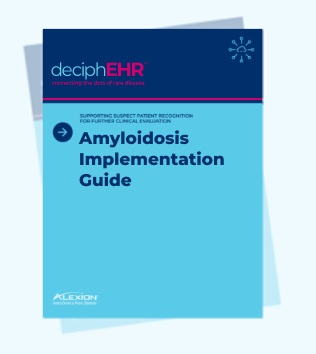Amyloidosis is a group of rare, heterogeneous, progressive diseases that can lead to organ
dysfunction and eventual death1
- Amyloidosis is a treatable disease characterized by the misfolding of proteins that form amyloid
fibrils that aggregate in tissues and/or organs, which can result in organ failure1,2
- Patients with amyloidosis present with a wide variety of nonspecific symptoms that often mimic
more common diseases, which can complicate diagnosis and lead to misdiagnosis and
mistreatment2,3
- Misdiagnosis and diagnostic delays are associated with a high risk for morbidity and mortality amongst patients4,5 and a large cost to healthcare organizations (HCOs)6,7
Take action with an amyloidosis toolkit.
Leveraging EHRs may help health organizations triage patients for further evaluation8
Why amyloidosis patient recognition is important?

Untreated, ATTR can lead to confinement to a wheelchair, heart failure, and death, but timely
diagnosis and treatment is associated with improved survival.1,2,9

Misdiagnosis and subsequent mistreatment can lead to clinical worsening and early mortality in
amyloidosis patients10,11; accurate diagnoses are needed to
prevent.

Effective therapy exists and needs to be initiated as soon as possible to prevent further organ
damage.5
ATTR=transthyretin amyloidosis.
References: 1. Baker KR, Rice L. The amyloidoses: Clinical features, diagnosis and treatment. Methodist Debakey Cardiovasc J. 2012;8(3):3-7. 2. Cuddy SAM, Falk RH. Amyloidosis as a systemic disease in context. Can J Cardiol. 2020;36(3):396-407. 3. Nativi-Nicolau JN, Karam C, Khella S, Maurer MS. Screening for transthyretin amyloidosis in the clinic: overlapping disorders, misdiagnosis, and multiorgan awareness. Heart Fail Rev. 2022;27(3):785-793. 4. Gertz MA. Hereditary ATTR: Burden of illness and diagnostic challenges. Am J Manag Care. 2017;23(7 Suppl):S107-S112. 5. Gertz MA, Dispenzieri A. Systemic amyloidosis recognition, prognosis, and therapy: A systematic review. JAMA. 2020;324(1):79-89. 6. Quock TP, D'Souza A, Broder MS, Bognar K, Chang E, Tarbox MH. In-hospital mortality in amyloid light chain amyloidosis: Analysis of the Premier Healthcare Database. J Comp Eff Res. 2023;12(2):e220185. 7. Quock TP, Yan T, Tieu R, D'Souza A, Broder MS. Untangling the clinical and economic burden of hospitalization for cardiac amyloidosis in the United States. Clinicoecon Outcomes Res. 2019;11:431-439. 8. Ben-Assuli O, Sagi D, Leshno M, Ironi A, Ziv A. Improving diagnostic accuracy using EHR in emergency departments: a simulation-based study. J Biomed Inform. 2015;55:31-40. 9. Hawkins PN, Ando Y, Dispenzeri A, Gonzalez-Duarte A, Adams D, Suhr OB. Evolving landscape in the management of transthyretin amyloidosis. Ann Med. 2015;47(8):625-638. 10. Lousada I, Maurer M, Guthrie SD, Hsu K, Grogan M. Amyloidosis Research Consortium Cardiac Amyloidosis Survey: Results From Patients With AL Amyloidosis and Their Caregivers. Presented at: European Hematology Association (EHA) 22nd Annual Congress 2017; June 22–25, 2017; Madrid, Spain. 11. Witteles RM, Bokhari S, Damy T, et al. Screening for transthyretin amyloid cardiomyopathy in everyday practice. JACC Heart Fail. 2019;7(8):709-716.




